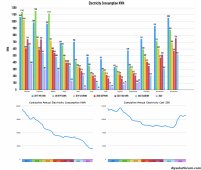- I turned off the immersion heater. It was on an "Economy 7" timer that basically means it only turned on overnight to try to save money, and then cooled throughout the day. Those things were built in an era of housewives, and as someone who lives alone and work during the day, it was just a waste - by the time I get home, most of the savings have cooled away. I turn it on when I need it now, and am looking at an instant hot-water heater and a power shower instead. Higher pull, sure, but far less power overall.



